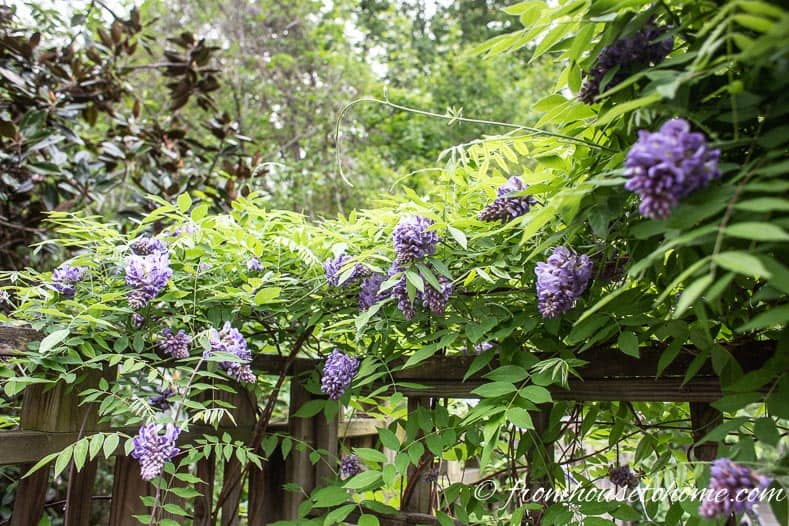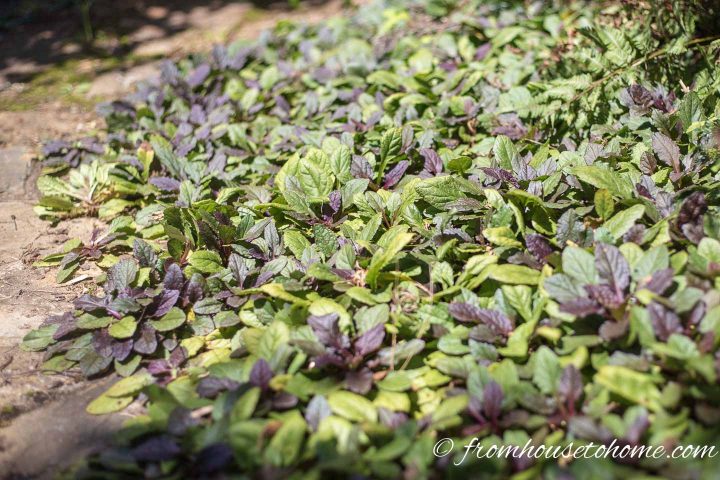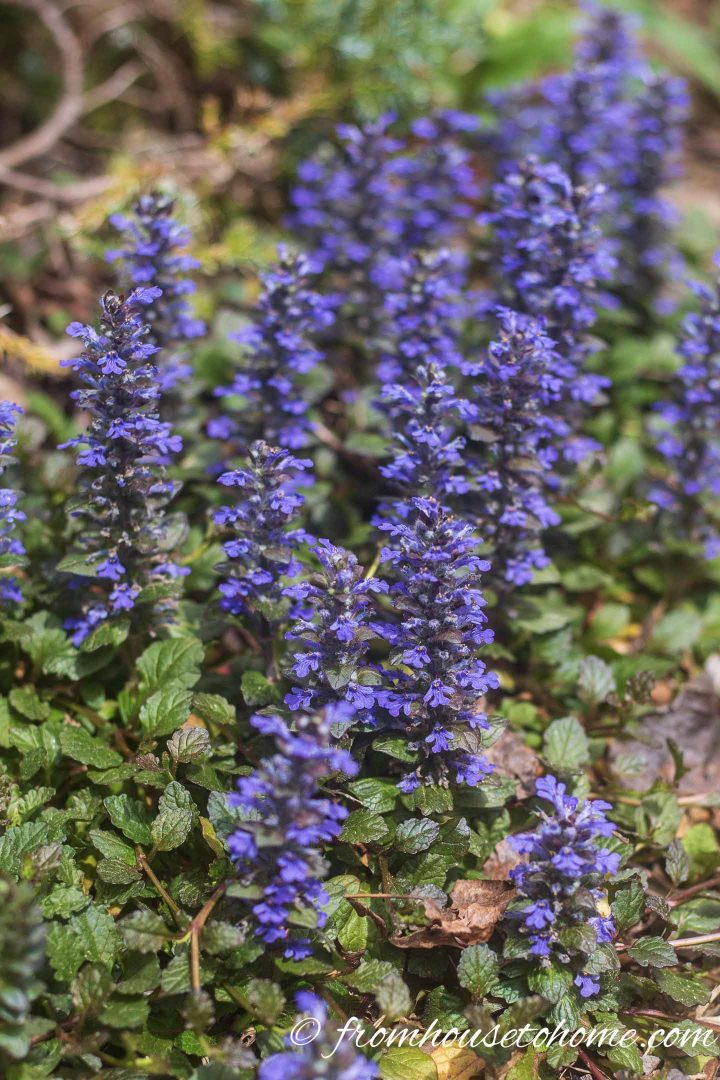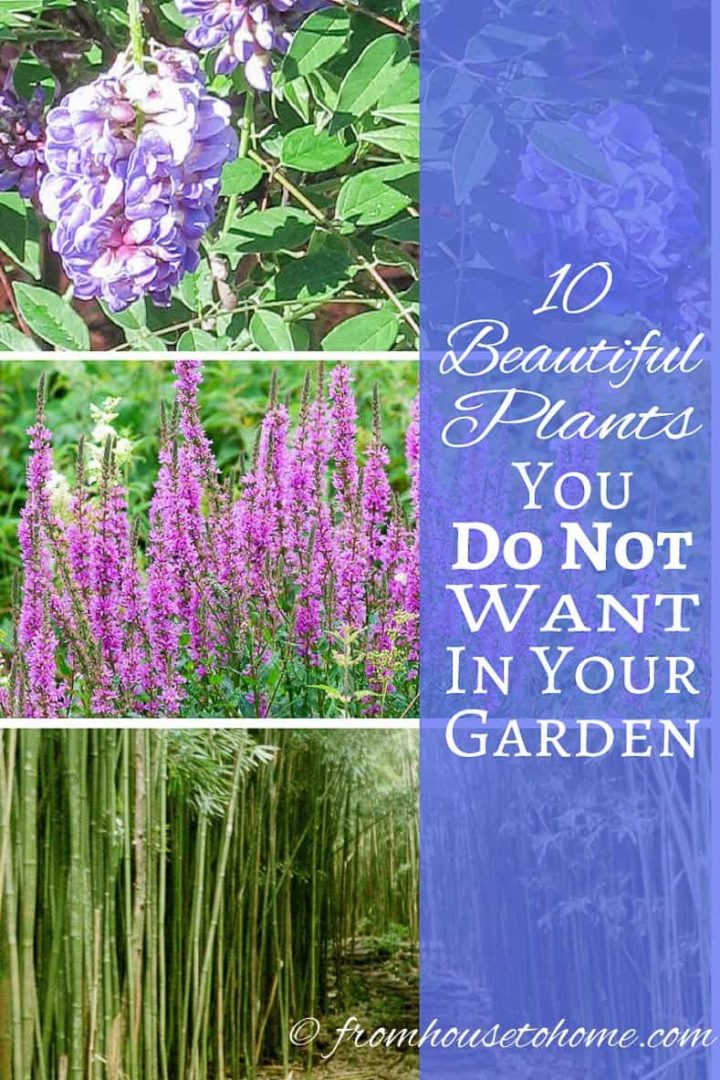Beautiful Invasive Plants You Do Not Want In Your Garden
These invasive plants are all beautiful so you will be tempted to plant them in your garden. Find out which invasive species are not worth the hassle.

If you've been gardening for a while, you have probably come across some plants that try to overtake your garden.
I know I have (unintentionally) planted a few invasive plants over the years.
And they add so much more work to the gardening process! So now I'm very careful about choosing plants that are better behaved. (If you read my post on low maintenance gardening, you know that even though I love my garden, I also don't want to spend all of my free time working in it.)
They other problem with invasive species is that most of them can easily escape your garden. When they set up shop in a natural habitat, they really cause a lot of damage to the native ecosystem.
Here are some of the most beautiful invasive plants you do not want in your garden.
Whether or not these (or any other) plants will become invasive in your garden depends on the growing conditions in your area.
The plants on this list can all be found on invasive plants lists maintained by state and university extension programs. Which means they have the potential to become invasive.
But if you live in an area where the growing conditions are not favorable for the plants, they may not cause any problems…or may not grow at all 🙂
If you're not sure how a plant will behave in your area, talk to your local nursery and other gardeners in your neighborhood to find out.
Or check the Invasive Plant Atlas for North America, which provides maps of where different varieties of plants are considered to be invasive.
1 | Purple Loosestrife (Lythrum salicaria)

Purple Loosestrife (Lythrum salicaria) is a very hardy perennial that spreads easily and can choke out a natural wetland (or field) very quickly.
The density of the shoots kills all other plants in its path, which is why it is on many invasive species lists across North America (and has even been banned in some places).

This picture of the Cooper Marsh Conservation Area in Ontario, Canada shows just how invasive it can be.
Garden varieties of Loosestrife are still for sale in some places, and are sometimes included in wildflower seed packets.
Since these can cross-polinate with wild varieties to create seeds, make sure to double-check what you are buying.
2 | Japanese Honeysuckle (Lonicera japonica)

I have never actually planted Japanese Honeysuckle, but I do have first hand experience with how invasive it is.
Some of it is growing wild in the ravine behind my house and it is impossible to keep under control. I actually think it is worse than the kudzu (and if you live in a location where kudzu grows, you know how invasive it is).
This Honeysuckle has white and yellow flowers that are really pretty, and it smells wonderful when it is blooming. But it is definitely not worth the trade off of trying to keep it from strangling all other living plants!
Once it escapes into the wild (as it inevitably seems to do), it is devastating to the environment.
There are non-invasive varieties of Honeysuckle which will be just fine in your garden. It's the Japanese version that can cause problems.
3 | Autumn Clematis (Clematis terniflora)

Autumn Clematis is not a plant that I ever would have guessed to be invasive.
All of the other clematis varieties I have grown have always been very well behaved.
I planted this on my fence a few years ago, and it never did much in my yard (I thought it had died).
Then I was out pulling the kudzu and honeysuckle outside my fence, and saw this other vine that was growing everywhere. The blooms looked a lot like the autumn clematis I had planted, but I thought it couldn't be the same plant.
So I looked it up and found it on the Invasive Plant Atlas for South Carolina.
Of course, there are many non-invasive varieties of Clematis which absolutely deserve a spot in your garden. Don't be afraid to plant those ones!
4 | Wisteria (all varieties)

I hate to add Wisteria to this list (it is really beautiful when it is blooming!)…but having lots of personal experience, I really can't leave it off…
When I moved to South Carolina, a lot of people warned me that I shouldn't plant Wisteria.
I even had a co-worker tell me a story about over-turning a rented Bobcat trying to pull out Wisteria from the ravine at the back of his yard. But that still didn't stop me from planting it.

I read that the Chinese (Wisteria sinensis) and Japanese versions (Wisteria floribunda) of Wisteria were invasive (you can find them on the Plant Conservation Alliance's Least Wanted Vines list), but the American variety (Wisteria frutescens) was not on the list.
So how bad could it be? (I have since found out that only non-native plant varieties are classified as “invasive”. So because this is a native variety, it isn't on the list.)

Now that I have it growing in my garden, I can vouch for the fact that once it gets going, even the native variety grows like crazy.
It starts out as a little plant, and it takes a little while to get going. But once it does, look out!
You have to be really vigilant about pruning to keep it where you want it. The picture above was taken in the spring after I had completely cut the wisteria down to the ground in the fall. By the time it started blooming, it had completely covered the fence.
Then if you ever want to remove it, good luck 🙂
I tried to dig up a plant at the back of my yard 7 or 8 years ago, and I am still pulling rogue Wisteria plants out of the garden in that spot.
The lesson learned is…if you love the look of Wisteria as much as I do, you need to be prepared to do some work to keep it contained!
5 | Lily of the Valley (Convallaria majalis)

Lily of the Valley is a pretty woodland plant that blooms in the spring and has a wonderful perfume.
They are very easy to grow and will spread like wild fire, which is the first reason you don't want them in your garden.
But the second (and maybe more important) reason is that these plants are extremely poisonous.
Any pets or children (or even adults) that eat part of the plant will require immediate medical treatment.
6 | Periwinkle (Vinca minor)

Periwinkle is an easy to grow evergreen ground cover that does well in the shade and is covered with really pretty blue flowers in the spring.
Sounds great, doesn't it?
However, it also will overrun every other plant in your garden if you let it.

It starts out well mannered and seems like the perfect plant to add some interest underneath other plants in your garden.
But after if has become established (which takes a few years), it will start to grow up the stems of other plants and choke out any smaller plants in its way. Cxcept for the weeds which still seem to survive.
You can see it in the background of this picture where it is beginning to get to the “takeover” stage.
This is another plant that I have spent many years trying to eradicate from my garden, without success so far.
7 | Non-Clumping Bamboo (Phyllostachys aurea)

Ever since I saw this bamboo forest on Maui, I have loved the look (and sound) of bamboo.
It adds such a relaxing feel to the garden.

And then I saw the bamboo that had been planted along the railway tracks in South Carolina to act as a sound barrier. Which has now taken over whole backyards.
It is incredibly difficult to remove or contain once it has become established.
Since bamboo is part of the grass family, it is literally like grass on steroids.
If you've ever tried to keep a running variety of grass (like Bermuda) out of your garden, you know how hard it is.
Then think of trying to do that if the grass were the size of a bamboo plant!
There are some clumping bamboo varieties that are not as invasive, so make sure you plant one of these if you want bamboo in your garden.
8 | Pampas Grass (Cortaderia selloana)

Pampas Grass is another large perennial grass that looks beautiful and is very easy to grow.
It also grows very quickly into a large clump and will self seed freely.
And that's where the problem starts.
It can easily crowd out all other plants if you are not vigilant about keeping it in check.
Then if you try to dig it up, it has a massive root system that is very difficult to remove.
9 | English Ivy (Hedera helix)

Like a lot of people, I used to love using English Ivy in my hanging baskets.
It always looks so nice trailing over the edge of the pot.
But if even one little piece of it touches the ground, you will have more ivy than you know what to do with.
That's also what makes it so hard to get rid of. You have to remove every little bit of it from the ground or it will grow back.
10 | Carpet Bugleweed (Ajuga reptans)

As the name suggests, Carpet Bugleweed (Ajuga reptans) is another ground cover that on the surface seems like a great addition to your garden.
It's a low growing evergreen with purple-green leaves and beautiful blue-purple flowers.
And then it starts to spread and it's impossible to pull out. The roots are in there, and like the ivy, any little piece left in the ground will grow.

In fact, in my yard, it not only takes over the garden but will totally cover the sidewalk, too if I let it.
If you are looking for a more comprehensive list of invasive plants, try the Invasive Plant Atlas for North America. The site was developed by The University of Georgia – Center for Invasive Species and Ecosystem Health and the National Park Service, and is maintained by several university, state and federal extension programs.
invasive.org is another organization that maintains a database of all kinds of invasive organisms (not just plants) for North America.
Both sites provide maps with each plant listing that let you know where the plant is considered to be invasive.
Other plants you might like better
Or browse all our perennial plant ideas.
Do you have experience with any other types of invasive plants? Tell us in the section below.
Pin It So You Don't Forget It!

This post was originally published on January 13, 2017 but was updated with new content on November 23, 2024.

































































4 O’ Clocks! I have the pink ones that have seeded all over my garden beds, throughout the lawn, and over the wood pile. These cannot be pulled out since they form giant tubers deep underground. I’ve had to dig plants out of the garden and try to dig these woody tubers up only to get small parts of them out. A complete menace.
Thanks for the addition to the list, Beverly!
Coreopsis is invasive as well as primrose. Once you get either hard to get rid. Especially primrose with traveling roots. I dug & dug and never was totally successful.
Houtynia, aka Chamelion plant!!!
Tri colored with a leaf resembling ivy.
Spreads like wildfire, and is so strong, it grew under a friend’s pond liner and up through the heavy pond liner.
It took 5 years of digging and Roundup to get rid of it.
Thanks for the addition to the list, Gary! It sounds like a nightmare.
Amen! I’ve planted a lot of perennials that I later wished I hadn’t. Chameleon plant is by far the worst!! The roots go down so deep it’s impossible to get them all out. They also spread outward into the grass and other areas. Alas, I found that is it not drought tolerant, so I removed from the bed what I wanted to keep and left the Chameleon plant to starve. Luckily, we had a very dry summer and that took care of the majority of it. A couple years of spraying roundup on the offshoots took care of the rest.
Thanks, Denise! I definitely won’t be planting Chameleon plant any time soon…but it’s good to know you can get rid of it by not watering 🙂
I too planted some Chamelion as a ground cover and it has invaded everything about it. I bought weed killer and hope that it does the trick. The roots are so long and deep.
Avoid the “Obedient Plant”, named for how it holds it head of flowers. Latin name is physostegia Virginia. I planted a small patch on a slope with poor soil and by the next year it had spreads its rhizomes 10 feet in each direction. Pulling it out is difficult because the rhizomes also grow quite deep.
Thanks for the addition, Claire! I have heard it’s hard to get rid of.
5 Leaf Akebia (Chocolate vine) . I’ve been trying to keep in under control for over 20 years! Yes, 20 years! I go out every spring and pull garbage containers full of it. So far I have managed to keep it out of the woods next door. If it likes where it is, you’ll never get rid of it.
Thanks, Diane! My mother had chocolate vine in her garden for a while, too…and she had lots of issues with it taking over, too.
A good rule of “ gardening thumb” is to plant natives to your area. Your birds and ecosystem will flourish. So much easier. Yet, unfortunately the big box stores do not focus on native plants. And we often find out the hard way – as I have on occasion such as when I planted Spurge that I bought at the hardware store… and it sprang up many feet away all over my garden. It looked beautiful …. but had to throw it away before too much invasion occurred. Also, I highly recommend avoid Liquid Amber (sweetgum trees) as they are horrifically invasive, sprouting up 100 ft away and they can destroy hardscapes.
Thanks for the additions to the list, Jackie! I agree, native plants are a good option, and are often harder to find than they should be.
Bachelor button. I’ve been trying to eradicate it for years. The roots on these blue , leafy flowers are thick , numerous, and spread like the heartiest of weeds! Stay away!!!
Thanks for the addition to the list, Lauren!
I’m new to your website and truly appreciate your information and pictures. Pictures are really helpful when choosing plants and as I’m a senior citizen I’m trying to select perennials that have a long bloom time that are also low maintenance. I had just purchased to pots of Ajuga Chocolate Chip as they were touted as low maintenance and drought tolerant. Thanks to your article I will not be planting them in my flower bed.
Thanks, Su! Yes, unfortunately many of the plants that are advertised as low maintenance tend to be aggressive, especially if they grow in adverse conditions (like dry soil, dense shade, etc.) I think when plant sellers say low maintenance they mean it doesn’t take much effort to get the plants to grow, not thinking about the effort required if they grow too much. Ajuga Chocolate Chip is a very pretty plant, so maybe you can plant it in a container to keep it contained.
Trumpet Vines get started and don’t stop spreading. The seed pods are everywhere and the roots run deep. They will cover everything.
Thanks for the addition to the list, Lorinda. I have heard trumpet vines are hard to keep in check!
Liriope. I’ve hit that stuff w/ weed killer (which I prefer not to use anywhere) over & over. I finally had to dig it all up… three times. One little piece & it’s got another foothold. I haven’t had trouble w/ the green & white version tho.
Thanks, Alison! I have heard that some varieties of Liriope are hard to contain.
Ligustrum sinense, Chinese Privet. This evergreen spreads thru extensive roots and tons of berries. It is literally all over our neighborhood ! It has a waxy leaf so weed killer kind of bounces off but it can be temporarily downed with repeated application but you end up cutting down the forest then pulling the roots up when shoots sprout from the stumps. The roots & even up-rooted my carport footings, bending the heavy metal-framed roof.
Thanks Melanie! I haven’t tried growing Chinese Privet but it sounds like a nightmare!
Greek oregano. It even ran over & killed off my mint plants that were planted a few feet away, if you can imagine that !
Thanks, Alison! Wow! If it can take over mint, it must be pretty aggressive 🙂
Trumpet vine is a total menace! I planted it for the humming birds and they loved it! But when it pulled the downspout off the house and up the shingles it was time to go. That is not an easy task, the roots that you don’t remove will start to grow everywhere like bindweed. It also readily reseeds. Glyphosate slows it down but does not eradicate it. I am still working on it three years later.
Give trumpet vine a pass.
Thanks, Laura! I have heard that trumpet vine is hard to get rid. Good luck with it!
I have planted a lot of Morning Glories through time and never had an issue. I planted Grampa Ott and while it is pretty, I have been trying to get rid of it ever since. It reseeds itself everywhere. I constantly pull them out and more spring up.
Thanks for the addition to the list, Chantel!
Mint of any kind spreads like crazy! If you want it for cooking or aroma plant it in containers or you’ll be fighting it for years! Also Asian Dayflower. It seems dainty and harmless but it is completely insidious and als takes years to eradicate
Thanks, Cheryl! I totally agree that mint should be kept in containers! I haven’t tried Asian Dayflower so good to know it’s trouble 🙂
Japanese anemones! They go beserk and are a real pain to get out as they sprout from even the smallest of root left behind. And let’s not forget goose neck loosestrife. Another mass invader.
Thanks! I have heard that Japanese anemones can be bad (I think some varieties are worse than others). And I agree, loosestrife is definitely on the list!
Is goutweed there on your list? Looks great but look out!
Thanks, Laura! I haven’t tried goutweed, so that’s good to know 🙂
Catmint took over my small garden.
Thanks for the addition to the list, Catherine!
TRUMPET VINE! I know it is touted as a great hummingbird lure, but I am seriously pulling it up by YARDS of roots! It is all over the yard of the house I bought last year. And any tiny piece of root grows more! I also found out (the hard way) it causes rashes- itchy, red, welty rashes! This might be why another name for it is “Cow itch”! Do yourself a huge favor- unless you want your yard looking like some abandoned, vine-covered haunted house- don’t plant it!
Thanks, Mia! I have heard that trumpet vine can be tough to control.
I put a trumpet vine on an arbor and when it started getting out of control I cut it down, it took 5 yrs and it still grew under my house beside the arbor of course I had to pull it up there too 😳
Thanks for the addition to the list, Katrina! I have heard that trumpet vine can be hard to get rid of 🙂
My issue ,I was given …Feverfew…pops up now all thru my yard…never again.
Pat C.
Thanks for the tip, Pat! I haven’t tried growing Feverfew, so it’s good to know I don’t want to try 🙂
I had a terrible time getting rid of trumpet vine, took 2 years before I was able to eradicate it. Every time it would pop up I would brush it with straight concentrate Round-up. It was a beautiful orange flowing plant, but became too invasive.
Thanks, Yvonne. I have heard that trumpet vine can be hard to keep under control. Good to know that concentrated Round up helps.